Consumers' Attitude towards Sustainability Practices: UK Research
VerifiedAdded on 2022/10/04
|54
|15725
|18
Report
AI Summary
This research report investigates the attitudes of consumers in the United Kingdom towards environmental sustainability practices employed by businesses. The study highlights that while sustainability is increasingly important, many UK companies haven't prioritized it, leading to negative consumer perceptions. The research uses a qualitative approach, including interviews, to explore the link between consumer attitudes and purchasing behavior. Key findings reveal a direct relationship between positive attitudes towards sustainability and business performance. The report examines the importance of green marketing and sustainable development for building a positive brand image. It also includes an analysis of consumer perceptions, identifies research limitations, and suggests areas for future study. The study concludes that businesses must prioritize sustainability to improve consumer perceptions and overall performance.
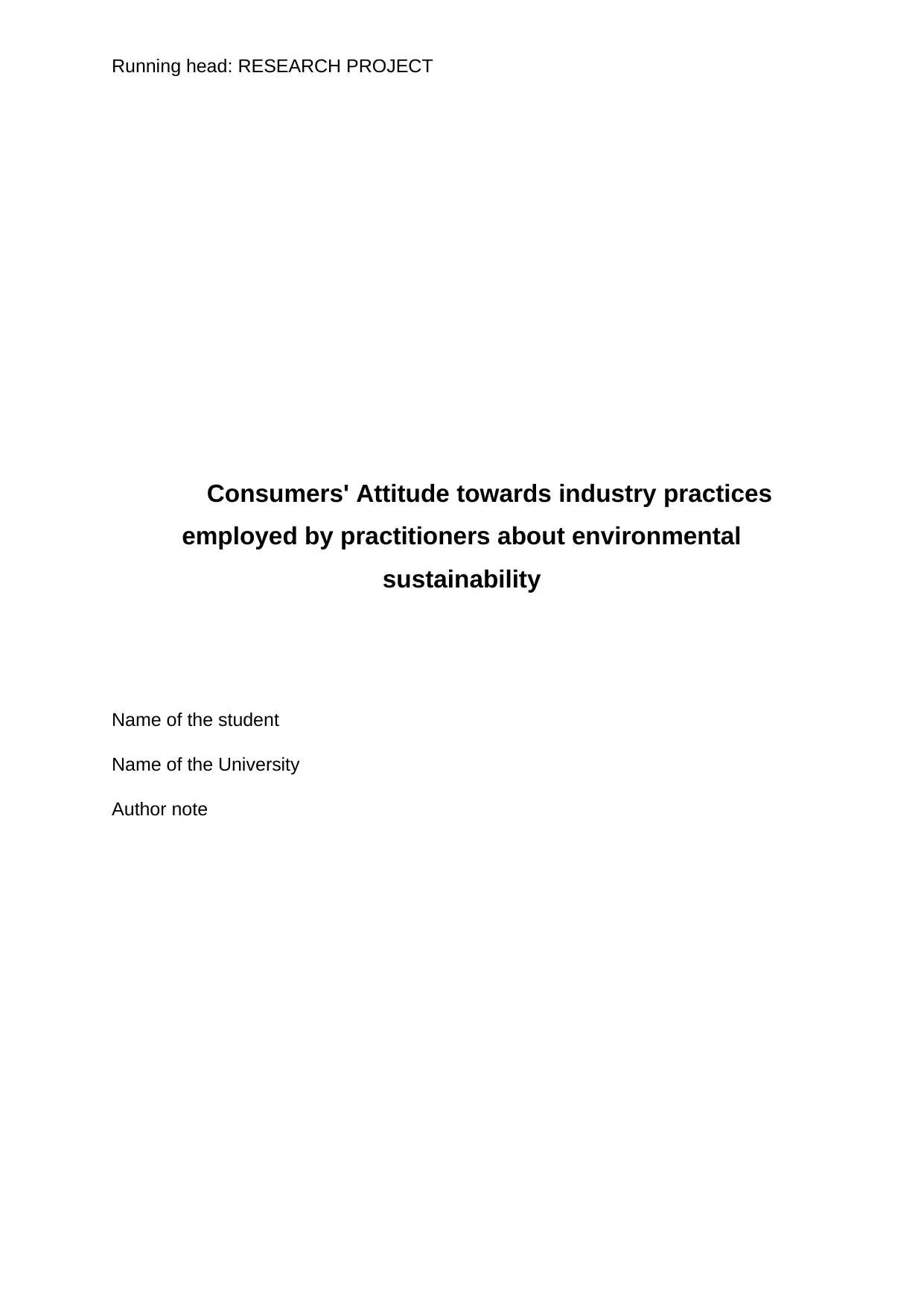
Running head: RESEARCH PROJECT
Consumers' Attitude towards industry practices
employed by practitioners about environmental
sustainability
Name of the student
Name of the University
Author note
Consumers' Attitude towards industry practices
employed by practitioners about environmental
sustainability
Name of the student
Name of the University
Author note
Paraphrase This Document
Need a fresh take? Get an instant paraphrase of this document with our AI Paraphraser

1RESEARCH PROJECT
Statement of Originality
I hereby declare that the project titled “Consumers' Attitude towards industry
practices employed by practitioners about environmental sustainability” is my own
work and I have carried this out under the supervision of _________.
I also certify that the work is my own original work and the work has not been
submitted to any other university. The guidelines mentioned by the University has
been followed in the report. We have provided credit to the authors by citing their
work at all times.
Statement of Originality
I hereby declare that the project titled “Consumers' Attitude towards industry
practices employed by practitioners about environmental sustainability” is my own
work and I have carried this out under the supervision of _________.
I also certify that the work is my own original work and the work has not been
submitted to any other university. The guidelines mentioned by the University has
been followed in the report. We have provided credit to the authors by citing their
work at all times.
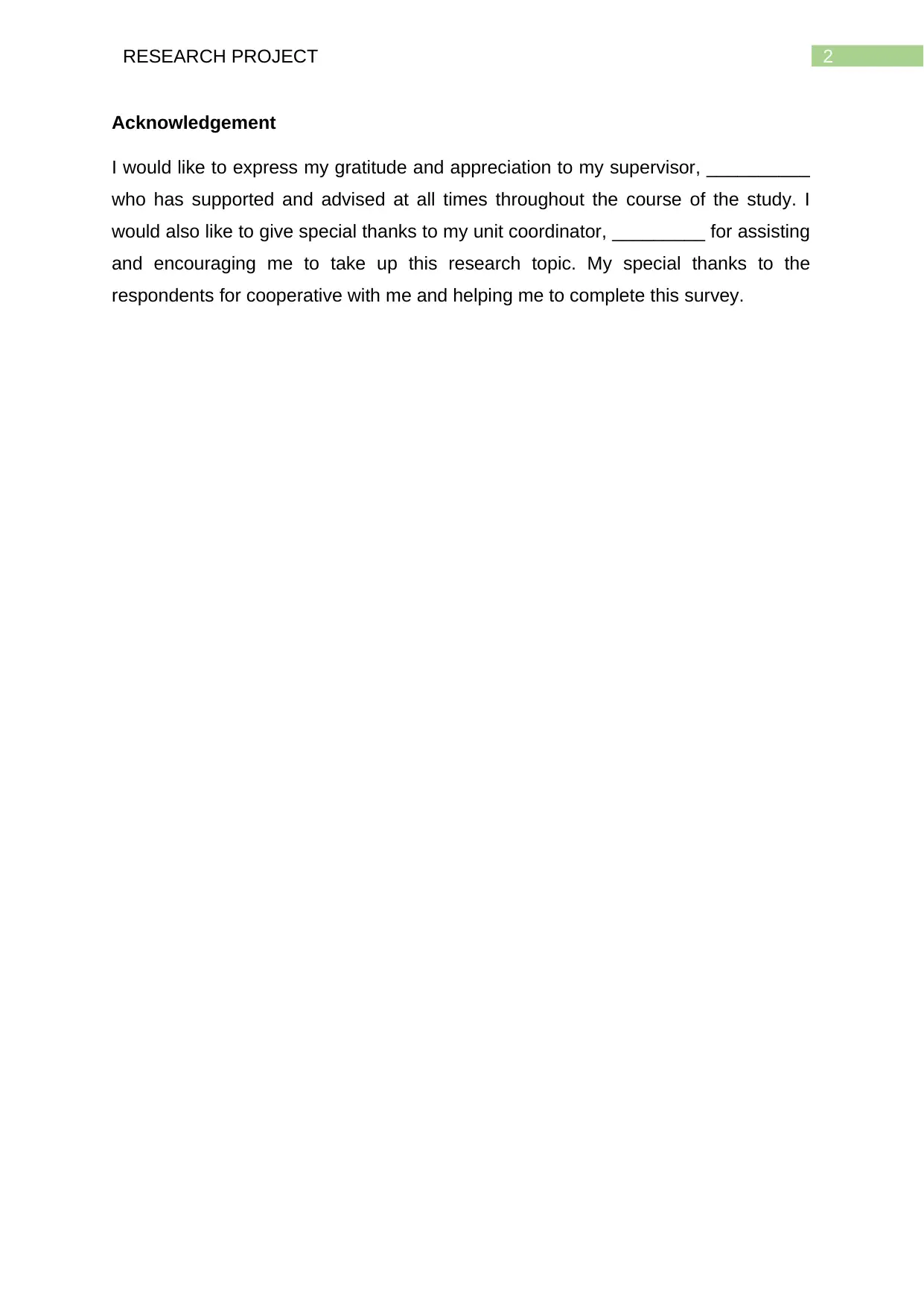
2RESEARCH PROJECT
Acknowledgement
I would like to express my gratitude and appreciation to my supervisor, __________
who has supported and advised at all times throughout the course of the study. I
would also like to give special thanks to my unit coordinator, _________ for assisting
and encouraging me to take up this research topic. My special thanks to the
respondents for cooperative with me and helping me to complete this survey.
Acknowledgement
I would like to express my gratitude and appreciation to my supervisor, __________
who has supported and advised at all times throughout the course of the study. I
would also like to give special thanks to my unit coordinator, _________ for assisting
and encouraging me to take up this research topic. My special thanks to the
respondents for cooperative with me and helping me to complete this survey.
⊘ This is a preview!⊘
Do you want full access?
Subscribe today to unlock all pages.

Trusted by 1+ million students worldwide
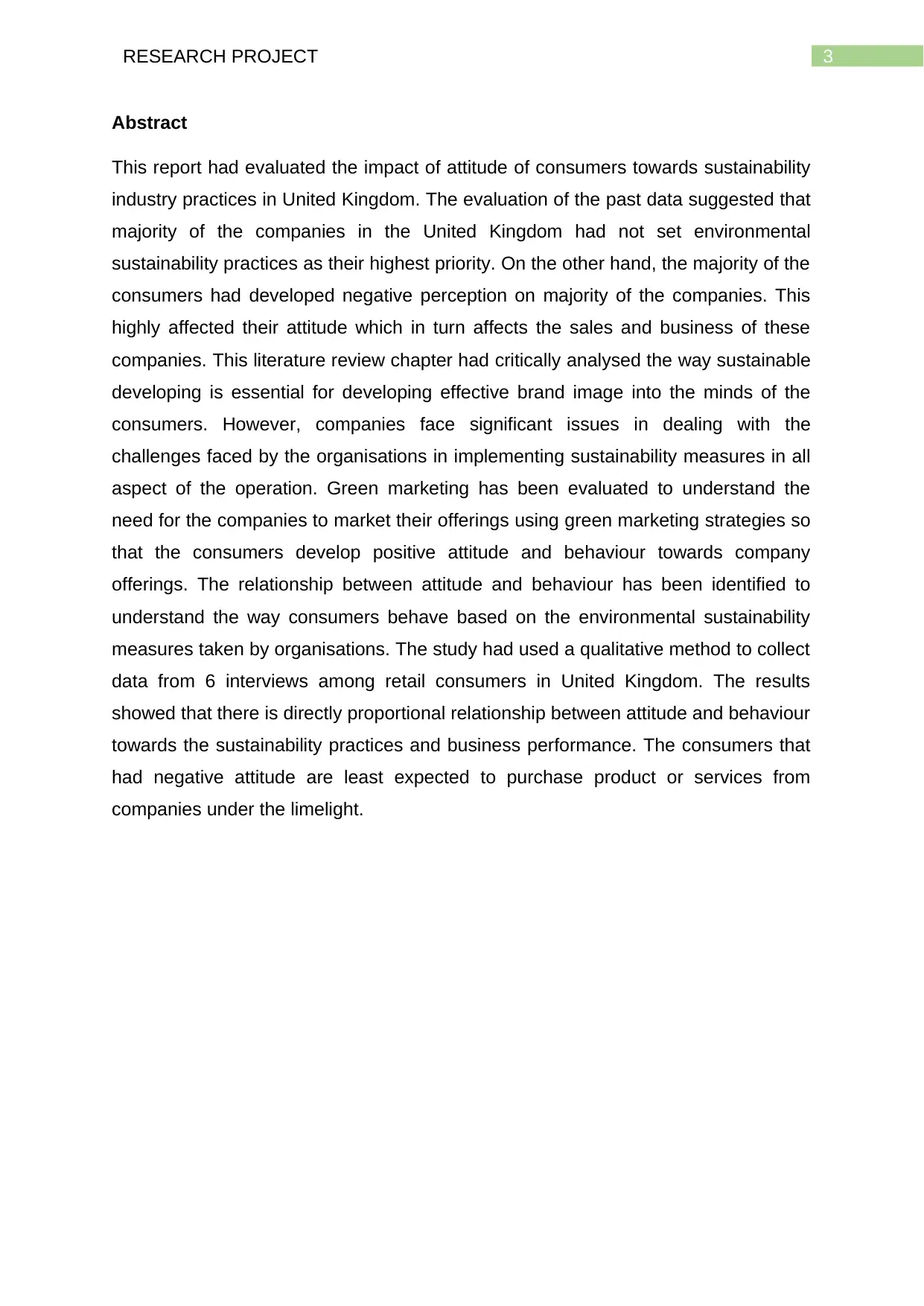
3RESEARCH PROJECT
Abstract
This report had evaluated the impact of attitude of consumers towards sustainability
industry practices in United Kingdom. The evaluation of the past data suggested that
majority of the companies in the United Kingdom had not set environmental
sustainability practices as their highest priority. On the other hand, the majority of the
consumers had developed negative perception on majority of the companies. This
highly affected their attitude which in turn affects the sales and business of these
companies. This literature review chapter had critically analysed the way sustainable
developing is essential for developing effective brand image into the minds of the
consumers. However, companies face significant issues in dealing with the
challenges faced by the organisations in implementing sustainability measures in all
aspect of the operation. Green marketing has been evaluated to understand the
need for the companies to market their offerings using green marketing strategies so
that the consumers develop positive attitude and behaviour towards company
offerings. The relationship between attitude and behaviour has been identified to
understand the way consumers behave based on the environmental sustainability
measures taken by organisations. The study had used a qualitative method to collect
data from 6 interviews among retail consumers in United Kingdom. The results
showed that there is directly proportional relationship between attitude and behaviour
towards the sustainability practices and business performance. The consumers that
had negative attitude are least expected to purchase product or services from
companies under the limelight.
Abstract
This report had evaluated the impact of attitude of consumers towards sustainability
industry practices in United Kingdom. The evaluation of the past data suggested that
majority of the companies in the United Kingdom had not set environmental
sustainability practices as their highest priority. On the other hand, the majority of the
consumers had developed negative perception on majority of the companies. This
highly affected their attitude which in turn affects the sales and business of these
companies. This literature review chapter had critically analysed the way sustainable
developing is essential for developing effective brand image into the minds of the
consumers. However, companies face significant issues in dealing with the
challenges faced by the organisations in implementing sustainability measures in all
aspect of the operation. Green marketing has been evaluated to understand the
need for the companies to market their offerings using green marketing strategies so
that the consumers develop positive attitude and behaviour towards company
offerings. The relationship between attitude and behaviour has been identified to
understand the way consumers behave based on the environmental sustainability
measures taken by organisations. The study had used a qualitative method to collect
data from 6 interviews among retail consumers in United Kingdom. The results
showed that there is directly proportional relationship between attitude and behaviour
towards the sustainability practices and business performance. The consumers that
had negative attitude are least expected to purchase product or services from
companies under the limelight.
Paraphrase This Document
Need a fresh take? Get an instant paraphrase of this document with our AI Paraphraser
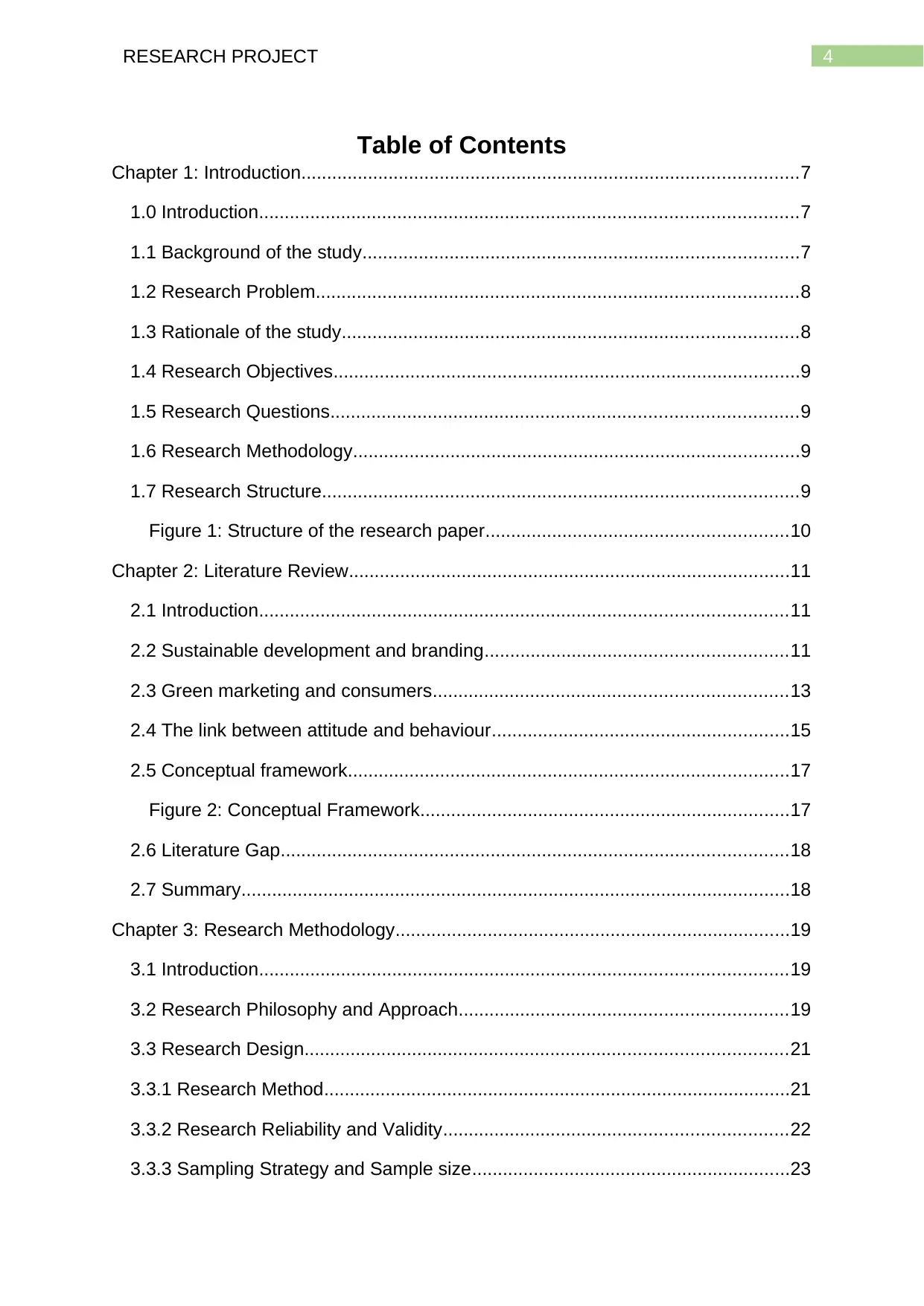
4RESEARCH PROJECT
Table of Contents
Chapter 1: Introduction.................................................................................................7
1.0 Introduction.........................................................................................................7
1.1 Background of the study.....................................................................................7
1.2 Research Problem..............................................................................................8
1.3 Rationale of the study.........................................................................................8
1.4 Research Objectives...........................................................................................9
1.5 Research Questions...........................................................................................9
1.6 Research Methodology.......................................................................................9
1.7 Research Structure.............................................................................................9
Figure 1: Structure of the research paper...........................................................10
Chapter 2: Literature Review......................................................................................11
2.1 Introduction.......................................................................................................11
2.2 Sustainable development and branding...........................................................11
2.3 Green marketing and consumers.....................................................................13
2.4 The link between attitude and behaviour..........................................................15
2.5 Conceptual framework......................................................................................17
Figure 2: Conceptual Framework........................................................................17
2.6 Literature Gap...................................................................................................18
2.7 Summary...........................................................................................................18
Chapter 3: Research Methodology.............................................................................19
3.1 Introduction.......................................................................................................19
3.2 Research Philosophy and Approach................................................................19
3.3 Research Design..............................................................................................21
3.3.1 Research Method...........................................................................................21
3.3.2 Research Reliability and Validity...................................................................22
3.3.3 Sampling Strategy and Sample size..............................................................23
Table of Contents
Chapter 1: Introduction.................................................................................................7
1.0 Introduction.........................................................................................................7
1.1 Background of the study.....................................................................................7
1.2 Research Problem..............................................................................................8
1.3 Rationale of the study.........................................................................................8
1.4 Research Objectives...........................................................................................9
1.5 Research Questions...........................................................................................9
1.6 Research Methodology.......................................................................................9
1.7 Research Structure.............................................................................................9
Figure 1: Structure of the research paper...........................................................10
Chapter 2: Literature Review......................................................................................11
2.1 Introduction.......................................................................................................11
2.2 Sustainable development and branding...........................................................11
2.3 Green marketing and consumers.....................................................................13
2.4 The link between attitude and behaviour..........................................................15
2.5 Conceptual framework......................................................................................17
Figure 2: Conceptual Framework........................................................................17
2.6 Literature Gap...................................................................................................18
2.7 Summary...........................................................................................................18
Chapter 3: Research Methodology.............................................................................19
3.1 Introduction.......................................................................................................19
3.2 Research Philosophy and Approach................................................................19
3.3 Research Design..............................................................................................21
3.3.1 Research Method...........................................................................................21
3.3.2 Research Reliability and Validity...................................................................22
3.3.3 Sampling Strategy and Sample size..............................................................23
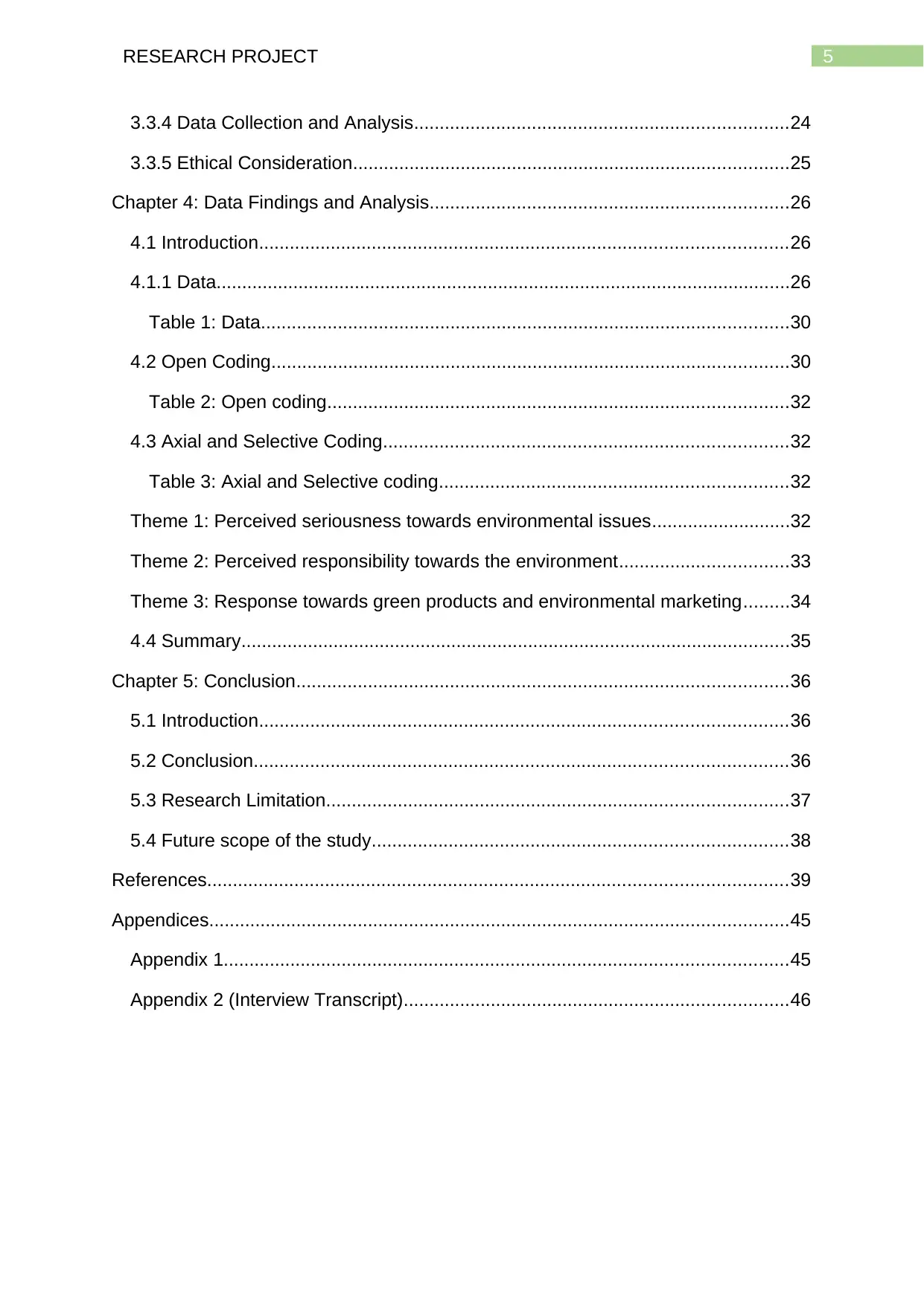
5RESEARCH PROJECT
3.3.4 Data Collection and Analysis.........................................................................24
3.3.5 Ethical Consideration.....................................................................................25
Chapter 4: Data Findings and Analysis......................................................................26
4.1 Introduction.......................................................................................................26
4.1.1 Data................................................................................................................26
Table 1: Data.......................................................................................................30
4.2 Open Coding.....................................................................................................30
Table 2: Open coding..........................................................................................32
4.3 Axial and Selective Coding...............................................................................32
Table 3: Axial and Selective coding....................................................................32
Theme 1: Perceived seriousness towards environmental issues...........................32
Theme 2: Perceived responsibility towards the environment.................................33
Theme 3: Response towards green products and environmental marketing.........34
4.4 Summary...........................................................................................................35
Chapter 5: Conclusion................................................................................................36
5.1 Introduction.......................................................................................................36
5.2 Conclusion........................................................................................................36
5.3 Research Limitation..........................................................................................37
5.4 Future scope of the study.................................................................................38
References.................................................................................................................39
Appendices.................................................................................................................45
Appendix 1..............................................................................................................45
Appendix 2 (Interview Transcript)...........................................................................46
3.3.4 Data Collection and Analysis.........................................................................24
3.3.5 Ethical Consideration.....................................................................................25
Chapter 4: Data Findings and Analysis......................................................................26
4.1 Introduction.......................................................................................................26
4.1.1 Data................................................................................................................26
Table 1: Data.......................................................................................................30
4.2 Open Coding.....................................................................................................30
Table 2: Open coding..........................................................................................32
4.3 Axial and Selective Coding...............................................................................32
Table 3: Axial and Selective coding....................................................................32
Theme 1: Perceived seriousness towards environmental issues...........................32
Theme 2: Perceived responsibility towards the environment.................................33
Theme 3: Response towards green products and environmental marketing.........34
4.4 Summary...........................................................................................................35
Chapter 5: Conclusion................................................................................................36
5.1 Introduction.......................................................................................................36
5.2 Conclusion........................................................................................................36
5.3 Research Limitation..........................................................................................37
5.4 Future scope of the study.................................................................................38
References.................................................................................................................39
Appendices.................................................................................................................45
Appendix 1..............................................................................................................45
Appendix 2 (Interview Transcript)...........................................................................46
⊘ This is a preview!⊘
Do you want full access?
Subscribe today to unlock all pages.

Trusted by 1+ million students worldwide

6RESEARCH PROJECT
List of Tables and Figures
Figure 1: Structure of the research paper..................................................................10
Figure 2: Conceptual Framework...............................................................................17
Table 1: Data..............................................................................................................30
Table 2: Open coding.................................................................................................32
Table 3: Axial and Selective coding...........................................................................32
List of Tables and Figures
Figure 1: Structure of the research paper..................................................................10
Figure 2: Conceptual Framework...............................................................................17
Table 1: Data..............................................................................................................30
Table 2: Open coding.................................................................................................32
Table 3: Axial and Selective coding...........................................................................32
Paraphrase This Document
Need a fresh take? Get an instant paraphrase of this document with our AI Paraphraser
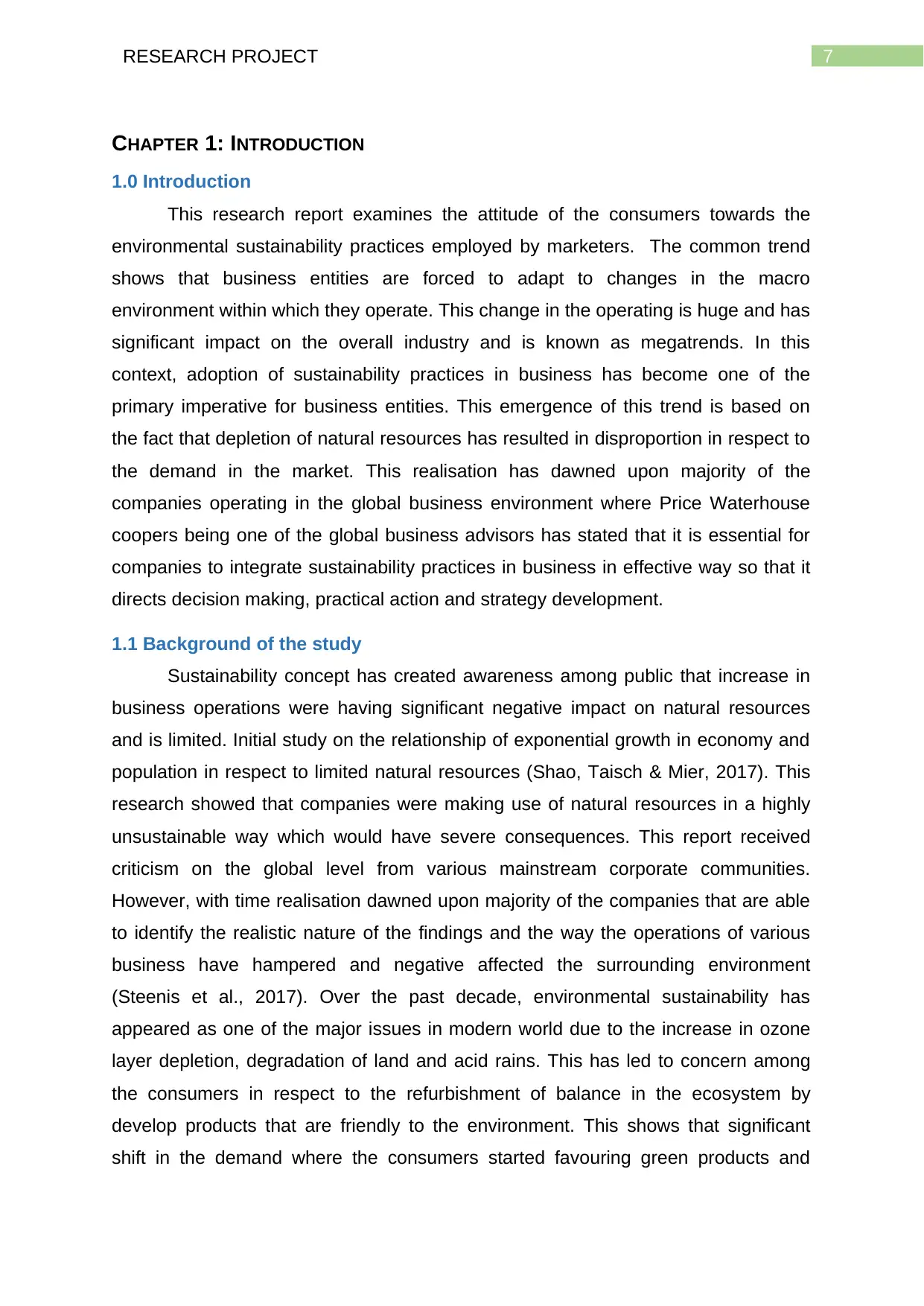
7RESEARCH PROJECT
CHAPTER 1: INTRODUCTION
1.0 Introduction
This research report examines the attitude of the consumers towards the
environmental sustainability practices employed by marketers. The common trend
shows that business entities are forced to adapt to changes in the macro
environment within which they operate. This change in the operating is huge and has
significant impact on the overall industry and is known as megatrends. In this
context, adoption of sustainability practices in business has become one of the
primary imperative for business entities. This emergence of this trend is based on
the fact that depletion of natural resources has resulted in disproportion in respect to
the demand in the market. This realisation has dawned upon majority of the
companies operating in the global business environment where Price Waterhouse
coopers being one of the global business advisors has stated that it is essential for
companies to integrate sustainability practices in business in effective way so that it
directs decision making, practical action and strategy development.
1.1 Background of the study
Sustainability concept has created awareness among public that increase in
business operations were having significant negative impact on natural resources
and is limited. Initial study on the relationship of exponential growth in economy and
population in respect to limited natural resources (Shao, Taisch & Mier, 2017). This
research showed that companies were making use of natural resources in a highly
unsustainable way which would have severe consequences. This report received
criticism on the global level from various mainstream corporate communities.
However, with time realisation dawned upon majority of the companies that are able
to identify the realistic nature of the findings and the way the operations of various
business have hampered and negative affected the surrounding environment
(Steenis et al., 2017). Over the past decade, environmental sustainability has
appeared as one of the major issues in modern world due to the increase in ozone
layer depletion, degradation of land and acid rains. This has led to concern among
the consumers in respect to the refurbishment of balance in the ecosystem by
develop products that are friendly to the environment. This shows that significant
shift in the demand where the consumers started favouring green products and
CHAPTER 1: INTRODUCTION
1.0 Introduction
This research report examines the attitude of the consumers towards the
environmental sustainability practices employed by marketers. The common trend
shows that business entities are forced to adapt to changes in the macro
environment within which they operate. This change in the operating is huge and has
significant impact on the overall industry and is known as megatrends. In this
context, adoption of sustainability practices in business has become one of the
primary imperative for business entities. This emergence of this trend is based on
the fact that depletion of natural resources has resulted in disproportion in respect to
the demand in the market. This realisation has dawned upon majority of the
companies operating in the global business environment where Price Waterhouse
coopers being one of the global business advisors has stated that it is essential for
companies to integrate sustainability practices in business in effective way so that it
directs decision making, practical action and strategy development.
1.1 Background of the study
Sustainability concept has created awareness among public that increase in
business operations were having significant negative impact on natural resources
and is limited. Initial study on the relationship of exponential growth in economy and
population in respect to limited natural resources (Shao, Taisch & Mier, 2017). This
research showed that companies were making use of natural resources in a highly
unsustainable way which would have severe consequences. This report received
criticism on the global level from various mainstream corporate communities.
However, with time realisation dawned upon majority of the companies that are able
to identify the realistic nature of the findings and the way the operations of various
business have hampered and negative affected the surrounding environment
(Steenis et al., 2017). Over the past decade, environmental sustainability has
appeared as one of the major issues in modern world due to the increase in ozone
layer depletion, degradation of land and acid rains. This has led to concern among
the consumers in respect to the refurbishment of balance in the ecosystem by
develop products that are friendly to the environment. This shows that significant
shift in the demand where the consumers started favouring green products and
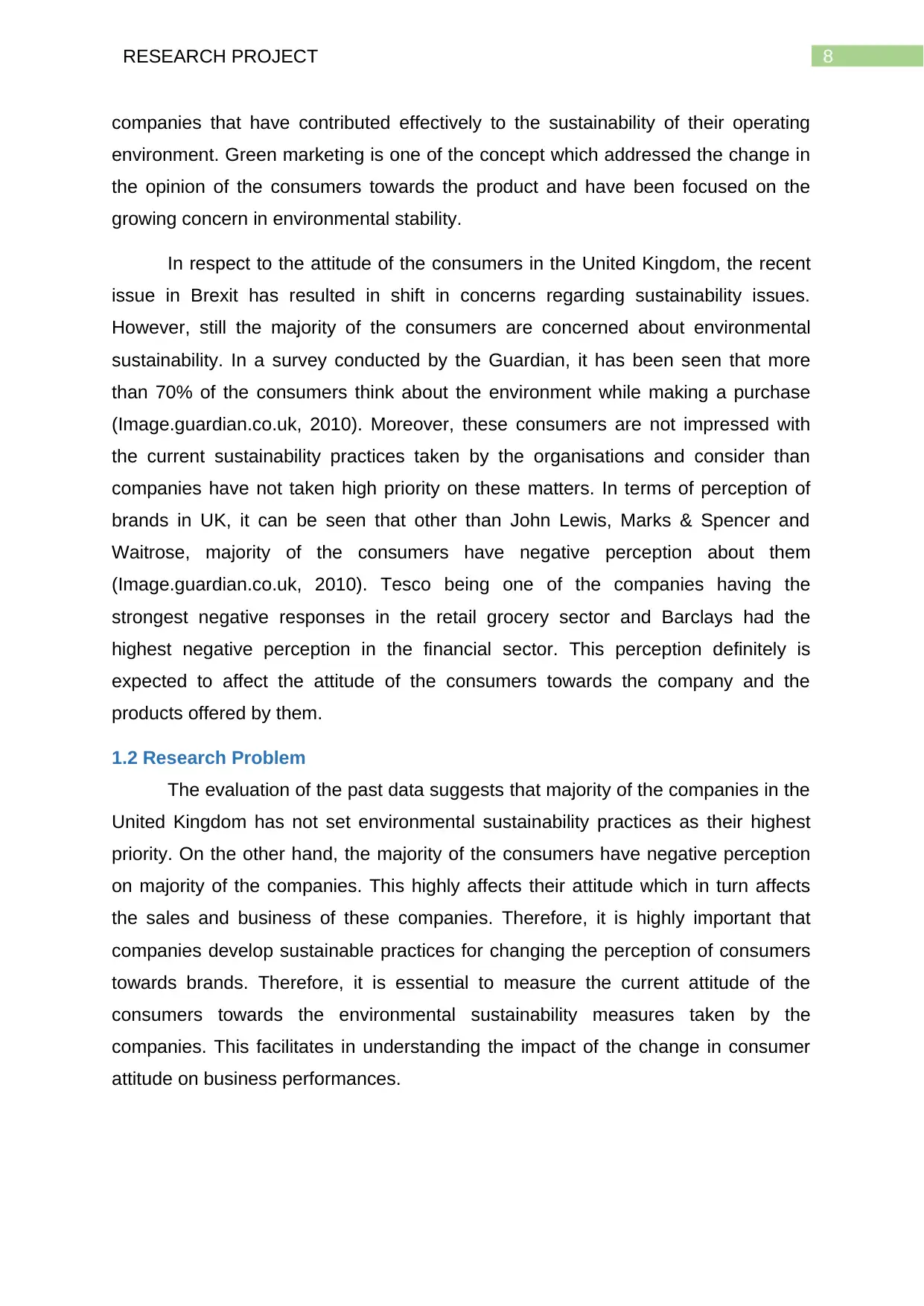
8RESEARCH PROJECT
companies that have contributed effectively to the sustainability of their operating
environment. Green marketing is one of the concept which addressed the change in
the opinion of the consumers towards the product and have been focused on the
growing concern in environmental stability.
In respect to the attitude of the consumers in the United Kingdom, the recent
issue in Brexit has resulted in shift in concerns regarding sustainability issues.
However, still the majority of the consumers are concerned about environmental
sustainability. In a survey conducted by the Guardian, it has been seen that more
than 70% of the consumers think about the environment while making a purchase
(Image.guardian.co.uk, 2010). Moreover, these consumers are not impressed with
the current sustainability practices taken by the organisations and consider than
companies have not taken high priority on these matters. In terms of perception of
brands in UK, it can be seen that other than John Lewis, Marks & Spencer and
Waitrose, majority of the consumers have negative perception about them
(Image.guardian.co.uk, 2010). Tesco being one of the companies having the
strongest negative responses in the retail grocery sector and Barclays had the
highest negative perception in the financial sector. This perception definitely is
expected to affect the attitude of the consumers towards the company and the
products offered by them.
1.2 Research Problem
The evaluation of the past data suggests that majority of the companies in the
United Kingdom has not set environmental sustainability practices as their highest
priority. On the other hand, the majority of the consumers have negative perception
on majority of the companies. This highly affects their attitude which in turn affects
the sales and business of these companies. Therefore, it is highly important that
companies develop sustainable practices for changing the perception of consumers
towards brands. Therefore, it is essential to measure the current attitude of the
consumers towards the environmental sustainability measures taken by the
companies. This facilitates in understanding the impact of the change in consumer
attitude on business performances.
companies that have contributed effectively to the sustainability of their operating
environment. Green marketing is one of the concept which addressed the change in
the opinion of the consumers towards the product and have been focused on the
growing concern in environmental stability.
In respect to the attitude of the consumers in the United Kingdom, the recent
issue in Brexit has resulted in shift in concerns regarding sustainability issues.
However, still the majority of the consumers are concerned about environmental
sustainability. In a survey conducted by the Guardian, it has been seen that more
than 70% of the consumers think about the environment while making a purchase
(Image.guardian.co.uk, 2010). Moreover, these consumers are not impressed with
the current sustainability practices taken by the organisations and consider than
companies have not taken high priority on these matters. In terms of perception of
brands in UK, it can be seen that other than John Lewis, Marks & Spencer and
Waitrose, majority of the consumers have negative perception about them
(Image.guardian.co.uk, 2010). Tesco being one of the companies having the
strongest negative responses in the retail grocery sector and Barclays had the
highest negative perception in the financial sector. This perception definitely is
expected to affect the attitude of the consumers towards the company and the
products offered by them.
1.2 Research Problem
The evaluation of the past data suggests that majority of the companies in the
United Kingdom has not set environmental sustainability practices as their highest
priority. On the other hand, the majority of the consumers have negative perception
on majority of the companies. This highly affects their attitude which in turn affects
the sales and business of these companies. Therefore, it is highly important that
companies develop sustainable practices for changing the perception of consumers
towards brands. Therefore, it is essential to measure the current attitude of the
consumers towards the environmental sustainability measures taken by the
companies. This facilitates in understanding the impact of the change in consumer
attitude on business performances.
⊘ This is a preview!⊘
Do you want full access?
Subscribe today to unlock all pages.

Trusted by 1+ million students worldwide
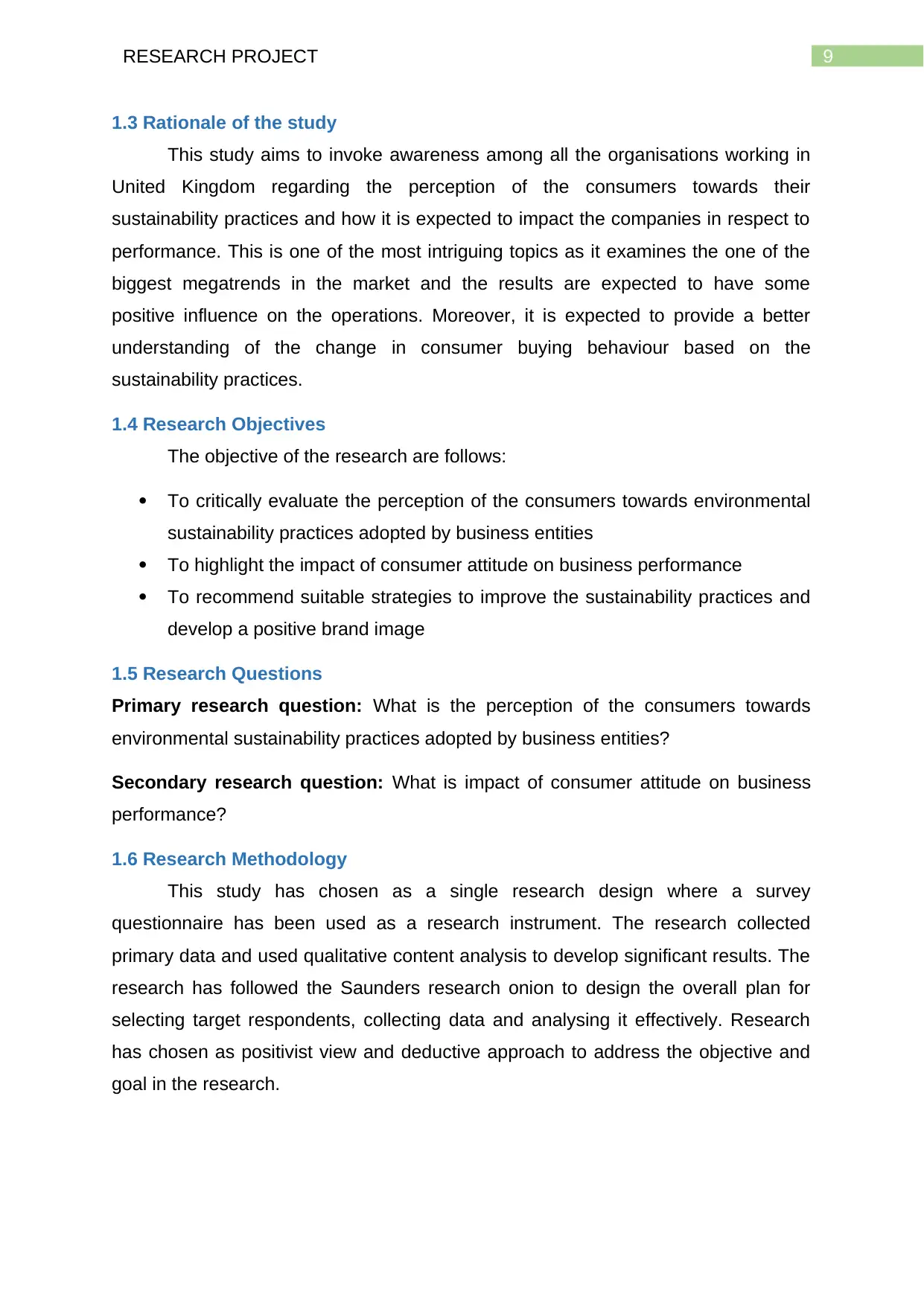
9RESEARCH PROJECT
1.3 Rationale of the study
This study aims to invoke awareness among all the organisations working in
United Kingdom regarding the perception of the consumers towards their
sustainability practices and how it is expected to impact the companies in respect to
performance. This is one of the most intriguing topics as it examines the one of the
biggest megatrends in the market and the results are expected to have some
positive influence on the operations. Moreover, it is expected to provide a better
understanding of the change in consumer buying behaviour based on the
sustainability practices.
1.4 Research Objectives
The objective of the research are follows:
To critically evaluate the perception of the consumers towards environmental
sustainability practices adopted by business entities
To highlight the impact of consumer attitude on business performance
To recommend suitable strategies to improve the sustainability practices and
develop a positive brand image
1.5 Research Questions
Primary research question: What is the perception of the consumers towards
environmental sustainability practices adopted by business entities?
Secondary research question: What is impact of consumer attitude on business
performance?
1.6 Research Methodology
This study has chosen as a single research design where a survey
questionnaire has been used as a research instrument. The research collected
primary data and used qualitative content analysis to develop significant results. The
research has followed the Saunders research onion to design the overall plan for
selecting target respondents, collecting data and analysing it effectively. Research
has chosen as positivist view and deductive approach to address the objective and
goal in the research.
1.3 Rationale of the study
This study aims to invoke awareness among all the organisations working in
United Kingdom regarding the perception of the consumers towards their
sustainability practices and how it is expected to impact the companies in respect to
performance. This is one of the most intriguing topics as it examines the one of the
biggest megatrends in the market and the results are expected to have some
positive influence on the operations. Moreover, it is expected to provide a better
understanding of the change in consumer buying behaviour based on the
sustainability practices.
1.4 Research Objectives
The objective of the research are follows:
To critically evaluate the perception of the consumers towards environmental
sustainability practices adopted by business entities
To highlight the impact of consumer attitude on business performance
To recommend suitable strategies to improve the sustainability practices and
develop a positive brand image
1.5 Research Questions
Primary research question: What is the perception of the consumers towards
environmental sustainability practices adopted by business entities?
Secondary research question: What is impact of consumer attitude on business
performance?
1.6 Research Methodology
This study has chosen as a single research design where a survey
questionnaire has been used as a research instrument. The research collected
primary data and used qualitative content analysis to develop significant results. The
research has followed the Saunders research onion to design the overall plan for
selecting target respondents, collecting data and analysing it effectively. Research
has chosen as positivist view and deductive approach to address the objective and
goal in the research.
Paraphrase This Document
Need a fresh take? Get an instant paraphrase of this document with our AI Paraphraser
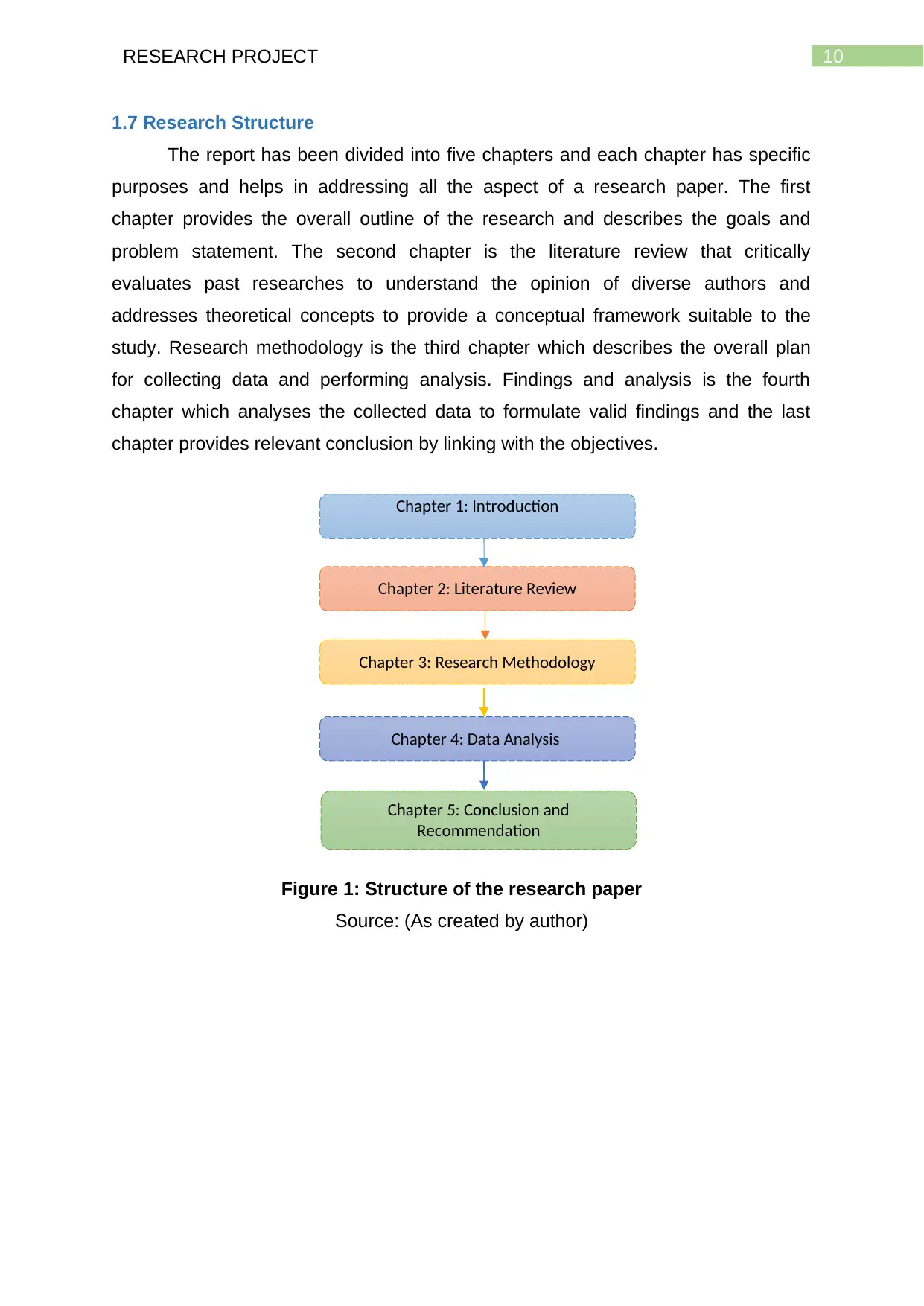
10RESEARCH PROJECT
1.7 Research Structure
The report has been divided into five chapters and each chapter has specific
purposes and helps in addressing all the aspect of a research paper. The first
chapter provides the overall outline of the research and describes the goals and
problem statement. The second chapter is the literature review that critically
evaluates past researches to understand the opinion of diverse authors and
addresses theoretical concepts to provide a conceptual framework suitable to the
study. Research methodology is the third chapter which describes the overall plan
for collecting data and performing analysis. Findings and analysis is the fourth
chapter which analyses the collected data to formulate valid findings and the last
chapter provides relevant conclusion by linking with the objectives.
Figure 1: Structure of the research paper
Source: (As created by author)
Chapter 5: Conclusion and
Recommendation
Chapter 4: Data Analysis
Chapter 1: Introduction
Chapter 2: Literature Review
Chapter 3: Research Methodology
1.7 Research Structure
The report has been divided into five chapters and each chapter has specific
purposes and helps in addressing all the aspect of a research paper. The first
chapter provides the overall outline of the research and describes the goals and
problem statement. The second chapter is the literature review that critically
evaluates past researches to understand the opinion of diverse authors and
addresses theoretical concepts to provide a conceptual framework suitable to the
study. Research methodology is the third chapter which describes the overall plan
for collecting data and performing analysis. Findings and analysis is the fourth
chapter which analyses the collected data to formulate valid findings and the last
chapter provides relevant conclusion by linking with the objectives.
Figure 1: Structure of the research paper
Source: (As created by author)
Chapter 5: Conclusion and
Recommendation
Chapter 4: Data Analysis
Chapter 1: Introduction
Chapter 2: Literature Review
Chapter 3: Research Methodology
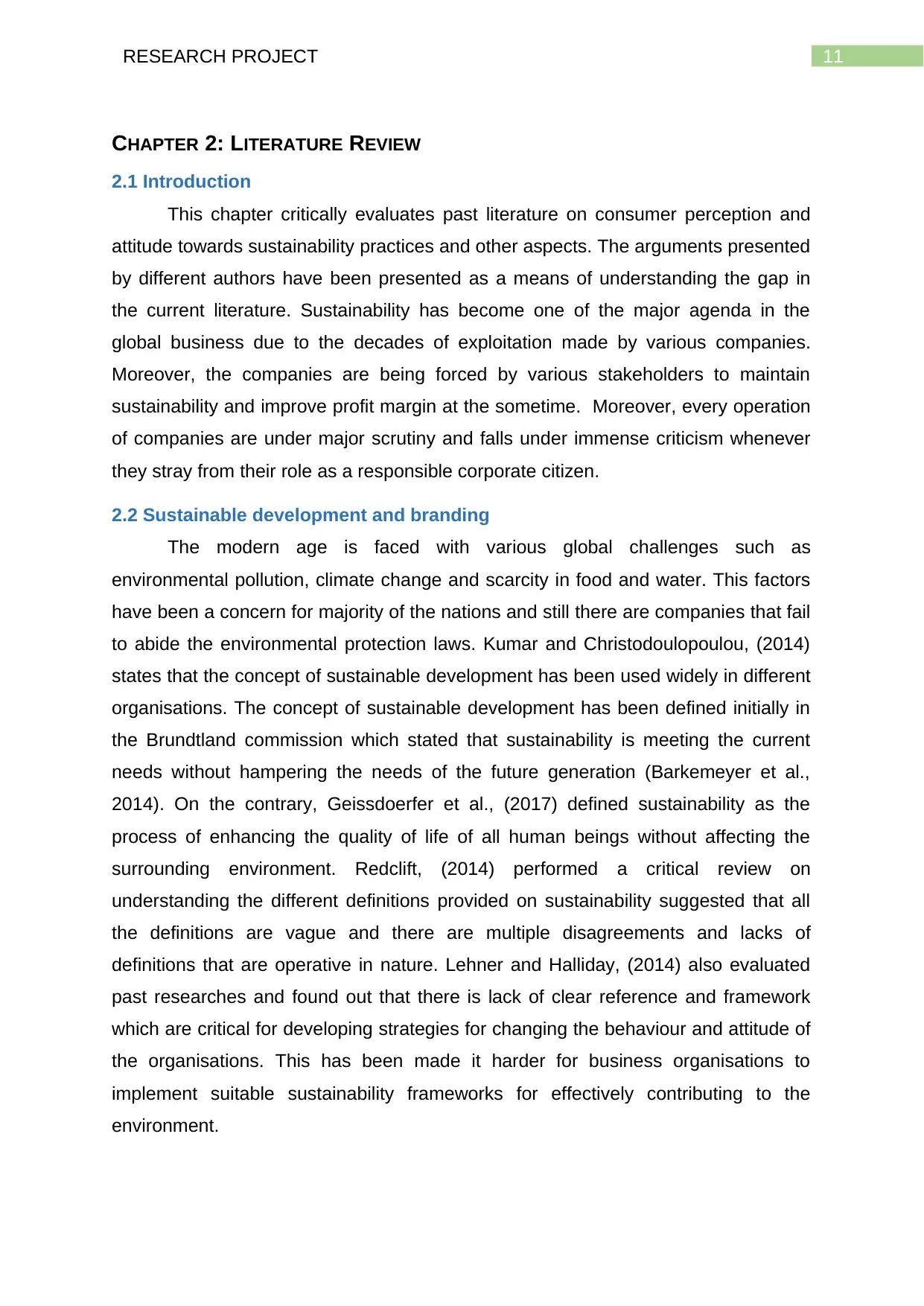
11RESEARCH PROJECT
CHAPTER 2: LITERATURE REVIEW
2.1 Introduction
This chapter critically evaluates past literature on consumer perception and
attitude towards sustainability practices and other aspects. The arguments presented
by different authors have been presented as a means of understanding the gap in
the current literature. Sustainability has become one of the major agenda in the
global business due to the decades of exploitation made by various companies.
Moreover, the companies are being forced by various stakeholders to maintain
sustainability and improve profit margin at the sometime. Moreover, every operation
of companies are under major scrutiny and falls under immense criticism whenever
they stray from their role as a responsible corporate citizen.
2.2 Sustainable development and branding
The modern age is faced with various global challenges such as
environmental pollution, climate change and scarcity in food and water. This factors
have been a concern for majority of the nations and still there are companies that fail
to abide the environmental protection laws. Kumar and Christodoulopoulou, (2014)
states that the concept of sustainable development has been used widely in different
organisations. The concept of sustainable development has been defined initially in
the Brundtland commission which stated that sustainability is meeting the current
needs without hampering the needs of the future generation (Barkemeyer et al.,
2014). On the contrary, Geissdoerfer et al., (2017) defined sustainability as the
process of enhancing the quality of life of all human beings without affecting the
surrounding environment. Redclift, (2014) performed a critical review on
understanding the different definitions provided on sustainability suggested that all
the definitions are vague and there are multiple disagreements and lacks of
definitions that are operative in nature. Lehner and Halliday, (2014) also evaluated
past researches and found out that there is lack of clear reference and framework
which are critical for developing strategies for changing the behaviour and attitude of
the organisations. This has been made it harder for business organisations to
implement suitable sustainability frameworks for effectively contributing to the
environment.
CHAPTER 2: LITERATURE REVIEW
2.1 Introduction
This chapter critically evaluates past literature on consumer perception and
attitude towards sustainability practices and other aspects. The arguments presented
by different authors have been presented as a means of understanding the gap in
the current literature. Sustainability has become one of the major agenda in the
global business due to the decades of exploitation made by various companies.
Moreover, the companies are being forced by various stakeholders to maintain
sustainability and improve profit margin at the sometime. Moreover, every operation
of companies are under major scrutiny and falls under immense criticism whenever
they stray from their role as a responsible corporate citizen.
2.2 Sustainable development and branding
The modern age is faced with various global challenges such as
environmental pollution, climate change and scarcity in food and water. This factors
have been a concern for majority of the nations and still there are companies that fail
to abide the environmental protection laws. Kumar and Christodoulopoulou, (2014)
states that the concept of sustainable development has been used widely in different
organisations. The concept of sustainable development has been defined initially in
the Brundtland commission which stated that sustainability is meeting the current
needs without hampering the needs of the future generation (Barkemeyer et al.,
2014). On the contrary, Geissdoerfer et al., (2017) defined sustainability as the
process of enhancing the quality of life of all human beings without affecting the
surrounding environment. Redclift, (2014) performed a critical review on
understanding the different definitions provided on sustainability suggested that all
the definitions are vague and there are multiple disagreements and lacks of
definitions that are operative in nature. Lehner and Halliday, (2014) also evaluated
past researches and found out that there is lack of clear reference and framework
which are critical for developing strategies for changing the behaviour and attitude of
the organisations. This has been made it harder for business organisations to
implement suitable sustainability frameworks for effectively contributing to the
environment.
⊘ This is a preview!⊘
Do you want full access?
Subscribe today to unlock all pages.

Trusted by 1+ million students worldwide
1 out of 54
Related Documents
Your All-in-One AI-Powered Toolkit for Academic Success.
+13062052269
info@desklib.com
Available 24*7 on WhatsApp / Email
![[object Object]](/_next/static/media/star-bottom.7253800d.svg)
Unlock your academic potential
Copyright © 2020–2025 A2Z Services. All Rights Reserved. Developed and managed by ZUCOL.





